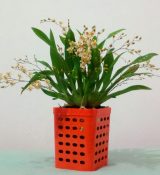Staking and Flowering Orchids
Author: adminNo Comments
Blooming, Care and Culture, Growing Indoors, Growing Outdoors
For an attractive presentation, whether in a greenhouse, in your home, or on a show-bench, nearly all inflorescences need some kind of training. It is best to place a cane of suitable size and length adjacent to each flower spike soon after it appears.
A pointed cane or stiff wire can be pushed into the compost, not too close to the side of the pot where active roots might be squashed. Indicating the emergence of spikes in this way also prevents accidental damage to them during routine work in the greenhouse. Young flower spikes can be tied to the cane as they develop, starting when they are 4-6in (10-15cm) high.
Most orchids flower once a year according to the season, although some hybrids flower more frequently. Odontoglossum species and hybrids, for example, will flower at ten-month intervals under ideal conditions and Phalaenopsis hybrids twice a year. Many orchid genera produce long inflorescences bearing many flowers, but most plants of Paphiopedilum and Lycaste species and hybrids bear flowers singly.
Orchids which naturally produce arching or pendulous spikes are best trained in their natural shape with stiff wire supports. The support should be kept to a minimum, depending on the length of the spray. Solitary flowers often need only a single tie, just below the pedicel, and multi-flowered orchids should have the top tie just below the first flower.
The presentation of flowers and spikes is best when plants are not moved, or even turned around, while the buds are developing, because they often re-orient themselves in relation to the strongest source of light when they have been moved. This can result in bent and twisted rather than gracefully arching spikes.


Ask an Expert
Questions about orchids?
Our experts love a challenge!
Photo of the Week
Submit your photo to be featured on the blog!
More Photo of the Week Winners
Submit Photo







